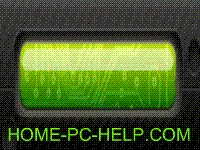Waveguide input-output Methods
The three waveguide input-output devices used to inject or remove energy from waveguides are PROBES, LOOPS, and SLOTS. Slots may also be called APERTURES or WINDOWS.
A waveguide, as explained earlier in this section, operates differently from an ordinary transmission line. Therefore, special devices must be used to put energy into a waveguide at one end and remove it from the other end.
As previously discussed, when a small probe is inserted into a waveguide and supplied with microwave energy, it acts as a quarter-wave antenna. Current flows in the probe and sets up an E field such as the one shown in the first figure below, view A. The E lines detach themselves from the probe. When the probe is located at the point of highest efficiency, the E lines set up an E field of considerable intensity.
View A: Probe coupling in a rectangular waveguide.
View B: Probe coupling in a rectangular waveguide.
View C: Probe coupling in a rectangular waveguide.
View D: Probe coupling in a rectangular waveguide.
The most efficient place to locate the probe is in the center of the "a" wall, parallel to the "b" wall, and one quarter-wavelength from the shorted end of the waveguide, as shown in view B, and view C. This is the point at which the E field is maximum in the dominant mode. Therefore, energy transfer (coupling) is maximum at this point. Note that the quarter-wavelength spacing is at the frequency required to propagate the dominant mode.
In many applications a lesser degree of energy transfer, called loose coupling, is desirable. The amount of energy transfer can be reduced by decreasing the length of the probe, by moving it out of the center of the E field, or by shielding it. Where the degree of coupling must be varied frequently, the probe is made retractable so the length can be easily changed.
The size and shape of the probe determines its frequency, bandwidth, and power-handling capability. As the diameter of a probe increases, the bandwidth increases. A probe similar in shape to a door knob is capable of handling much higher power and a larger bandwidth than a conventional probe. The greater power-handling capability is directly related to the increased surface area. Two examples of broad-bandwidth probes are illustrated in view D. Removal of energy from a waveguide is simply a reversal of the injection process using the same type of probe.
Another way of injecting energy into a waveguide is by setting up an H field in the waveguide. This will be discussed in the next tutorial.
Become a loyal member to our site. It's free!
Site Search


Translate your page
If English is not your first language you can Translate the text on this page to any one of the languages found in the drop down menu. Select your language from the list for an instant translation.
Looking for something unique for your project? Choose from the drop down menu for quick access to the item you seek.
Related Pages
Become an Electronics Technician
Convert most anything with this utility
Find your wire and cable here!
Sponsored Sites


If you like this site please pay it forward. Donations are welcome.
















